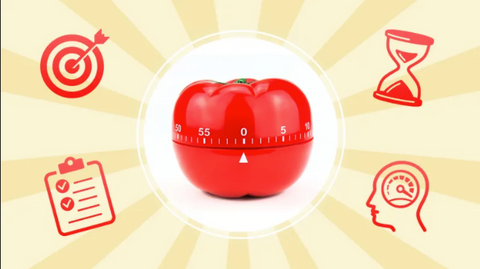The Pomodoro Technique
There's not one magic productivity technique that's guaranteed to work for every single person. That said, there are noted methods that have a proven success record for many. Today we will be sharing the Pomodoro Technique.

What is the Pomodoro Technique?
Created in the late 1980s by Francesco Cirillo, the Pomodoro Technique is a time management method that relies on timed intervals. The premise is simple: work for 25 minutes, rest for 5 minutes, and repeat. This meditated approach works based on the assumption that anyone can be productive for twenty-five minutes. After all, that is a pretty short amount of time in the grand scheme of things.
What do I need to do with the Pomodoro Technique?
To try the Pomodoro Technique out for yourself, you'll need:
•A task that will take at least 25 minutes
•A timer. The technique was actually named for the tomato-shaped kitchen timer Cirillo used in his studies while developing this method ("pomodoro" is Italian for tomato). If you don't have a kitchen timer, you can use your phone or these helpful websites: https://tomato-timer.com/ or https://www.pomonow.com/
•Pen and paper to keep track of your progress
Pretty simple! There's no reason why you can't get started right now, you probably have all the tools you need right in front of you.

How does the Pomodoro Technique work?
The Pomodoro Technique works well because it's sustainable: You can keep it up for hours. To begin, decide on a task that needs to be done and set your timer for 25 minutes.
During this time, work on the task at hand. No distractions, just get it done. You'll probably be pleasantly surprised by how much you're able to accomplish.
Once the timer goes off, put a checkmark on your piece of paper and enjoy a five-minute break. And no, this isn't one of those "five minute" breaks that somehow manages to get away from you and goes way longer than intended. Keep yourself honest; set the timer for your break, too. At the end of the five minutes, work for another 25 minutes. You get where we're going with this. Every work+break sequence is referred to as 1 pomodoro.
When you've marked four checkmarks on your paper (denoting 4 pomodoros; this should take 2 hours to complete), reward yourself with a longer break. Cirillo suggests this break should last 20-30 minutes, which gives your brain enough time to rest and thoughtfully encode new information learned from your hours of hard work.
Cirillo suggests you repeat this sequence again. For first-time users, it may be helpful to just commit to that first round of 4 pomodoros and then assess from there.
Benefits of the Pomodoro Technique
The Pomodoro Technique works well for a few reasons: It's simple, easy to replicate, and doesn't require getting your hands on anything you don't already own. It's also been applauded for its ability to manage and reframe distraction. For this reason, it especially works well for adults with ADHD, anxiety, or other issues that may impede on long-term focus.
Because the Pomodoro Technique has breaks explicitly built-in, there's no shame surrounding them. When using the technique, you can enjoy your breaks because you've worked for them. This changes your mindset and allows you to view a break as a beneficial time to recharge and refocus. By contrast, if you're constantly getting off track–even if it's just for 30 seconds to 1 minute–that time is considered instead to be a distraction, creating a vicious cycle that's hard to break.
Drawbacks of the Pomodoro Technique
To be frank, there's not a lot of downside to this technique. This low-tech approach has been used in offices, schools, and even replicated in computer application software. This is probably because it's easy and fun to do (admit it: playing "beat the clock" is kind of thrilling), but it does have its drawbacks. It's not for everyone and every situation.
The biggest shortcoming of the Pomodoro Technique is the rigidity of time. Success is riding on that 25 minutes of work and 5-minute break, but sometimes it's hard to immediately switch gears at the drop of a hat, or rather the ring of a timer. For example, when you're in the zone, 25 minutes might not be enough time. What if you're in the middle of a task when time's up? What if you need more than five minutes to recharge before jumping back in? The lack of flexibility with the Pomodoro Technique is its one real flaw, but if you like being held accountable and always knowing what exactly is coming next, it should work quite well for you. But if you prefer to dictate how you spend your time and are able to anticipate when you need breaks (instead of being told), this might not be your perfect recipe for success.



